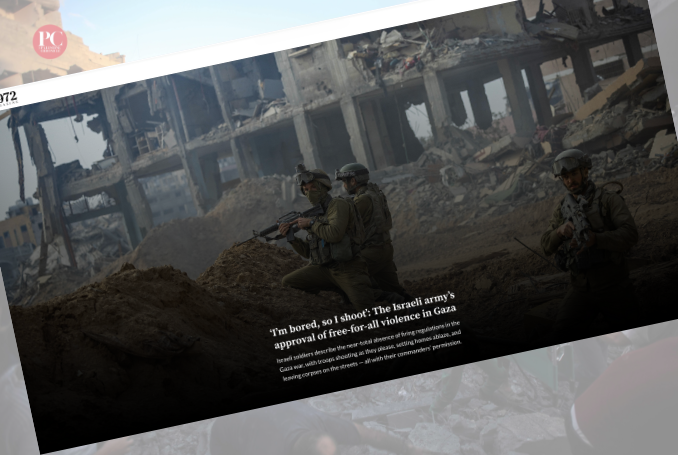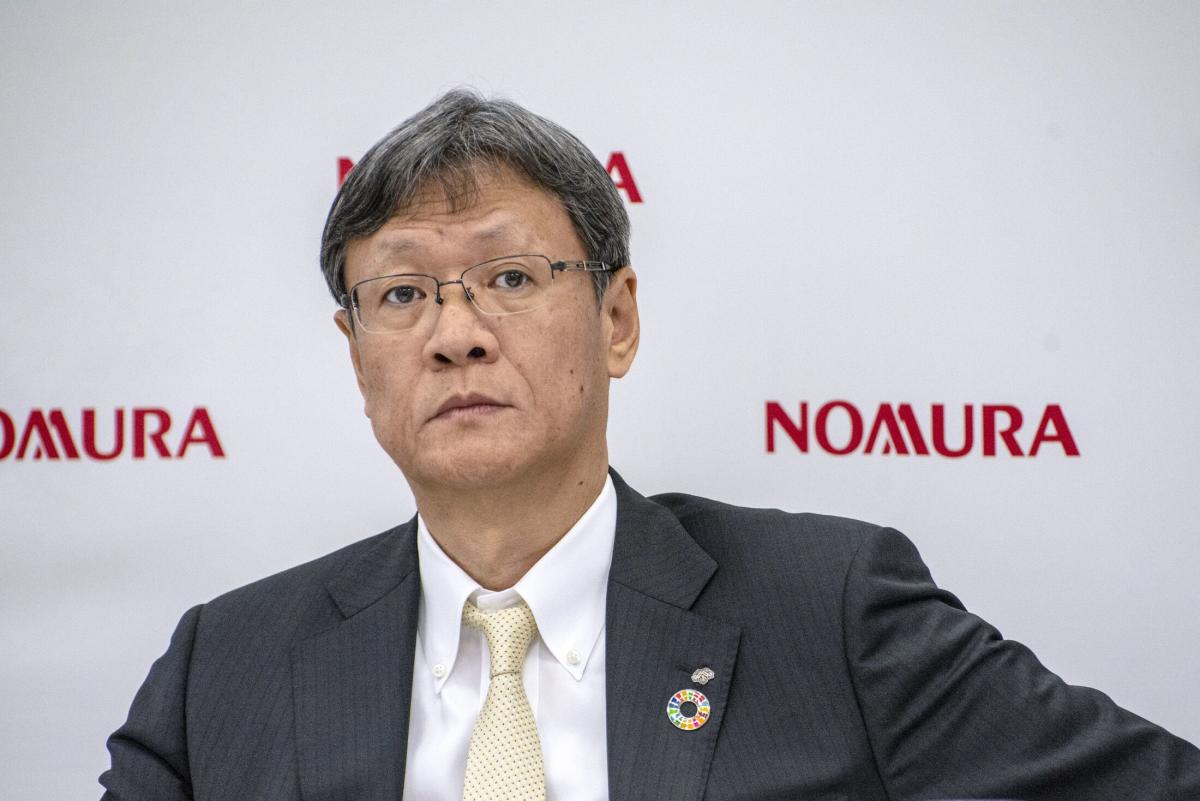“I’m bored, so I shoot” – Israeli soldiers describe “freedom of action” in Gaza

From the Palestine Chronicle editorial board 
“It is permissible to shoot anyone, a young girl, an old woman.”
The testimony of six Israeli soldiers has confirmed the statements of Palestinians throughout the ongoing war in Gaza. According to a revelation by the magazine +972, the soldiers were “authorized to open fire on Palestinians, including civilians, virtually at will.”
The soldiers, most of whom spoke on condition of anonymity, described an atmosphere of “complete freedom of action” in the enclave. Some Palestinian civilians were executed “just for entering an area that the military defined as a ‘no-go zone.'”
“Personally, I have fired a few bullets for no reason, into the sea, on the sidewalk or into an abandoned building. They report it as ‘normal fire,’ which is a code name for ‘I’m bored, so I’m shooting,'” a reservist named S. told the magazine.
The soldiers were all discharged from active service in the past few months.
“I killed him with four bullets” – Soldier boasts about killing unarmed elderly Palestinian (VIDEO)
Political sociologist Yagil Levy said that since the Second Intifada, “the army has stopped giving its soldiers written rules of engagement,” leaving much room for interpretation by commanders and soldiers on the ground, the report said.
“If there is even the slightest feeling of threat, you don’t need an explanation – you just shoot,” reported another soldier, B.
If someone approaches, he explained, “it is permissible to shoot at the center of the body, not in the air,” adding: “It is permissible to shoot at anyone, a young girl, an old woman.”
Shots fired at displaced evacuees
B also reported an incident in November in which soldiers killed several Palestinians during the evacuation of a school in Gaza City that had been used to house displaced people.
Evacuees were ordered to leave the building to the left, toward the sea, rather than to the right, where soldiers were, the report said.
“There was intelligence that Hamas wanted to create panic,” said B. “A battle started inside, people were running away. Some fled to the left towards the sea, others ran to the right, including children. Everyone who ran to the right was killed – 15 to 20 people. There were a pile of bodies.”
B also said it was difficult to distinguish between civilians and fighters, claiming that Hamas members often “walk around without weapons.” This means that “every man between the ages of 16 and 50 is suspected of being a terrorist.”
“The (army) believes that any contact (with the population) endangers the forces and a situation must be created in which it is forbidden to approach (the soldiers) under any circumstances. (The Palestinians) have learned that if we enter, they will run away.”
Call for “thorough investigation” – Israeli drone footage shows the killing of four Palestinians
“Demonstrate presence”
Soldiers also “shoot a lot, even without reason – anyone who wants to shoot, no matter what the reason, shoots,” S. said in a procedure known as a “presence demonstration.”
This happened even in areas that seemed deserted.
Another reservist named M. told the magazine that such orders came directly from the field commanders.
“When there are no (other) IDF forces (in the area) … there is unrestricted shooting, like crazy. And it is not only small arms that are used: machine guns, tanks and grenade launchers,” he said.
“War harms” prisoners
Yuval Green, 26, who asked the magazine to remain anonymous, said: “There were no ammunition restrictions,” adding: “People were just shooting to get bored.”
Green recently co-signed a letter from 41 reservists refusing to continue serving in Gaza, expressing concern that the rules of engagement posed a danger to the prisoners.
He said he was told about “a practice of blowing up tunnels, and I thought, if there are hostages in there, they will be killed.” After Israeli forces killed three prisoners waving white flags in Shejiya in December, Green said he was told, “There is nothing we can do.”
Green said the mood was: “We are here for the hostages,” but it was clear that the war was harming the hostages.
“No instructions”
Another officer, A, who served in the Army’s Operations Directorate, said: “From the moment you enter the building, there is no briefing at any point.”
“We did not receive any instructions from above that we could pass on to the soldiers and battalion commanders,” he added.
“Bloody massacre” – 50 Palestinians executed, 180 held by Israel in Al-Shifa Hospital
In addition to the instructions not to shoot along humanitarian routes, “for all other places, if there are no other instructions, you fill in the gaps. That’s the approach: ‘If it’s forbidden there, then it’s allowed here.'”
Soldier A said that firing at buildings such as hospitals, clinics, schools, religious institutions and buildings of international organizations “requires higher authorization,” the report said.
However, he said he could “count on one hand the number of times we were told not to shoot. Even in sensitive matters like schools, (the approval) feels like a mere formality.”
He said “the consensus” was that soldiers “shoot first and ask questions later,” adding: “Nobody will shed a tear if we unnecessarily raze a house to the ground or if we shoot someone we didn’t have to shoot.”
“Killing zones”
In April, the Israeli newspaper Haaretz reported on the establishment of “death zones” in the Gaza Strip, where orders were to shoot anyone entering them.
“That’s the default setting. There can’t be any civilians in the area, that’s the perspective. We spotted someone in a window, so they shot and killed him,” A said.
Even civilians who went into the areas passed by aid convoys in search of leftover food fell victim to the attack.
“If they cross the red line, you report it over the radio and you don’t have to wait for permission, you can shoot,” Soldier D. told the magazine.
Report: Israeli military sets up ‘kill zones’ in Gaza with orders to shoot ‘with intent to kill’
The soldiers “said that bodies of Palestinians in civilian clothes were scattered along the roads and in open areas throughout the Gaza Strip,” the magazine said.
Corpses disposed of
Another witness testified that the bodies were taken away along the route taken by the trucks before the aid convoys arrived.
“A D-9 (Caterpillar bulldozer) goes down with a tank, clears the area of bodies, buries them under the rubble and pushes them aside so that the convoys do not see them – (so) no pictures emerge of people in advanced stages of decomposition,” he explained.
Another soldier named C. told the magazine that unrestricted shooting could lead to friendly fire incidents, which are “more dangerous than Hamas.”
“IDF forces have fired in our direction several times,” said C.
According to the report, citing the army, at least 28 soldiers were killed in “friendly fire” incidents.
“Stirring up mass suffering” – Israeli army calls on “everyone” to leave Gaza City
‘Burn the house down’
Soldiers also told the magazine that it was common practice to burn down Palestinian homes after the occupation.
“Before you leave, burn the house – every house,” said one soldier. “This is supported at the level of battalion commanders. So (the Palestinians) cannot return, and if we leave ammunition or food behind, the terrorists cannot use it.”
An Israeli military spokesman stated in a detailed response to +972 magazine: “All IDF soldiers fighting in the Gaza Strip and on the borders received orders to open fire when hostilities began. These orders reflect international law, to which the IDF is bound.”
The spokesman said the instructions would be “regularly reviewed and updated in light of the changing operational and intelligence situation and approved by the most senior officials of the Israel Defense Forces.”
(The Palestine Chronicle)



